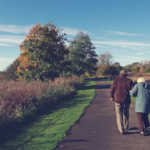The two most common forms of arthritis are osteoarthritis and rheumatoid arthritis, but there are over 100 different types in total with different causes and treatments.
Different types of arthritis
There are more than 100 different types of arthritis. The most common forms are Osteoarthritis and Rheumatoid arthritis, but rarer types can develop for different reasons and with varying results.
Which arthritis do I have?
Osteoarthritis
By far the most common form of joint disease, osteoarthritis damages the surface of the joint so that it doesn’t move as smoothly as it should. The cartilage covering the end of the bone becomes thin, while the bone itself thickens. This is caused by the body trying to repair the damage caused by the friction.
The effect is 3-fold. Firstly, the bone grows outwards, forming nodules. Secondly, the inner layer that produces fluid to ease joint movement, makes extra fluid that causes swelling. Thirdly, the ligaments that hold the joint together, thicken and tighten to give the joint more support, causing stiffness.
Symptoms include:
- Joint stiffness
- Periods of discomfort that’s better after rest
- If left joint will become inflamed and motion will be restricted
Rheumatoid arthritis
Is an autoimmune disease that targets the synovial tissues. Autoimmune diseases occur when the immune system mistakes healthy and necessary cells for hostile cells that need to be fought off. The result is that the immune cells begin to attack specific and harmless parts of the body. Synovial tissues include the synovial membrane, which is situated between bones in a joint, and contains synovial fluid that provides lubricant for the joint itself.
As the synovial tissue is attacked, the body attempts to heal itself, increasing blood flow to the area and causing inflammation. The inflammation causes pain as the ligaments attaching the bone to the muscle, stretch. When the flare-up subsides the ligaments are still stretched, which means the joint isn’t held in place as tightly as it should be. This means that the bone can settle in an unusual position, leading to further discomfort and/or deformity.
The immune system is body-wide, which is why rheumatoid arthritis usually occurs in multiple joints.
Symptoms include joints that are:
- Tender
- Swolloen
- Stiff and difficult to move
- Warm
- Red
- Spongy when pressed
- Affected symmetrically; for instance, both ankles or both wrists
And bodily symptoms include:
- Whole-body fatigue
- A low and constant fever
- General flu-like symptoms
- Weight loss/loss of appetite
If you would like to learn more about Arthritis; the history, causes, and the various treatments, see Arthritis: A Deeper Dive
Calcific periarthritis
Is caused by calcium deposits, or lumps, in the periarticular tissues. Periarticular tissues are the tissues surrounding a joint, such as the muscles in a shoulder. A third of cases occur after damage to the affected area. It can be difficult to diagnose as the symptoms are similar to those of other, more common conditions. Symptoms will usually calm down 4-7 days after the initial pain, and the calcium deposits will decrease in 2-3 weeks.
Symptoms include acute pain in the affected joint.
Enteropathic arthritis
EnA is a type of chronic, inflammatory arthritis that can be associated with inflammatory bowel disease (IBD), which includes ulcerative colitis and Crohn’s disease. Around 20% of those diagnosed with Crohn’s will develop enteropathic arthritis. EnA usually affects the limb joints and sometimes the spine.
Symptoms in the spine include:
- Back pain
- Back stiffness
Symptoms in the joints include:
- 4 or fewer affected joints
- Affected asymmetrically; for example, an elbow on one side and a wrist on the other
Gastrointestinal problems can begin soon after the arthritic symptoms, or at the same time.
Gouty arthritis
Gout is caused by a buildup of sodium urate crystals in the joints, usually in the big toe. These can be present without causing any trouble, but on occasion they can trigger an “attack of gout”. These attacks can come on very quickly and often occur during the night. Previously gout was considered “the disease of the rich” and it was put down to overeating and drinking too much. Now it’s known that, while eating and drinking too much may agitate gout, it’s actually caused by chemical processes that take place in the body. Urate can build-up to form crystals if the kidneys are unable to filter it out quickly enough.
Each attack usually lasts about a week, but if they continue untreated, they can become more regular and spread to affect more joints.
Symptoms often last 3 to 10 days, and can include:
- Heat and tenderness in the joint
- Swelling around the joint
- Red and shiny skin over the joint
- Peeling and flaky skin as the swelling reduces
If the gout is in the foot, it can cause mobility issues, and even the light pressure of a bed cover or blanket can be too much to bear.
Juvenile arthritis
Juvenile arthritis is a term that describes the many types of autoimmune and inflammatory conditions or diseases that can occur in children under the age of 16. Each type has its own characteristics and causes its own set of issues. Along with effects to the musculoskeletal system, juvenile arthritis can also affect the eyes, skin, muscles and gastrointestinal tract.
There is no known cause for juvenile arthritis, and there’s no evidence to suggest that toxins, foods or allergies have anything to do with it. Instead, genetic predisposition is a more likely cause.
The symptoms depend on the type of arthritis, and you can find out more about the types of juvenile arthritis here.
Polyarthritis
This simply means pain, with or without inflammation, affecting more than 4 joints. Once the symptoms are affecting more than 4 joints, there is significant risk that more will be affected over time. Monoarthritis is the term used to describe symptoms in 1 joint, and oligoarthritis normally means 2-4 joints.
Peripheral arthritis
Peripheral arthritis affects the elbows, wrists, knees and ankles. It doesn’t need to affect all joints at the same time, although the pain may ‘migrate’ from one joint to another. This type of arthritis is more common in people who have ulcerative colitis or Crohn’s disease, and the level of discomfort experienced in the joints affected, generally mirrors the discomfort experienced in the colon. When arthritis affects the spine, it is known as axial arthritis.
Psoriatic arthritis (PsA)
Psoriasis is an autoimmune disease skin condition that causes red, scaly rash commonly on the elbows, knees, back and scalp. Psoriasis leads to arthritis in 30% of patients, and some people have the arthritis without the skin symptoms. PsA causes inflammation both in and around the joint and it normally affects people who have already had the skin condition for some time. While psoriasis can affect people of any age, PsA normally affects more adults than young people.
Symptoms can include:
- Scaly and flaky skin, referred to as skin plaques
- Painful and stiff joints that are hot to the touch
- Joints that are affected asymmetrically, meaning that it affects 1 knee, or 1 elbow
- General fatigue
- Inflammation (conjunctivitis or iritis) in the eye, causing blurry vision and light sensitivity
Septic arthritis
Septic arthritis is caused by a bacterial infection and leads to inflammation in a joint. It can affect any joint and more than one joint might be affected at the same time. Treatment usually leads to a full recovery, but without treatment it can lead to permanent joint damage. As with all infections, if left untreated it can be life threatening.
Symptoms include:
- Severe pain
- Swelling
- Redness and heat in the affected joint/s
- Restricted movement
- High temperature (fever)
Caring for someone with arthritis
The key to helping someone with arthritis is to stay positive and be sensitive to their mental health and wellbeing. Pain isn’t fun, and the reality is that for most people with arthritis the condition will get worse, not better.
If you are caring for someone with arthritis, HomeTouch can help. Simply search by postcode and browse the profiles of self-employed carers near you. All of the carers on our site have gone through a thorough 42-point vetting process, and only 5% are accepted. You choose the carer you want to work with, and we provide support with contracts, payments, and holiday and sickness cover.
Find out more about arthritis and what you can do to make life with arthritis easier:
- What are arthritis nodules?
- What does arthritis feel like?
- Why arthritis hurts
- Where does arthritis affect?
- Top gadgets for self care
- Gadgets to help your elderly loved one outside
Sources:
- https://ard.bmj.com/content/annrheumdis/42/4/469.full.pdf
- https://link.springer.com/article/10.1007/s10140-007-0626-9
- https://www.spondylitis.org/Enteropathic-Arthritis
- https://rheuminfo.com/diseases/enteropathic-arthritis/
- https://www.arthritisresearchuk.org/arthritis-information/conditions/gout/what-is-gout.aspx
- https://www.verywell.com/what-is-polyarthritis-189659






